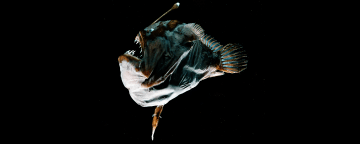Katarina Zimmer in The Scientist:
 Krøyer’s deep-sea anglerfish, Ceratias holboelli, does not spawn, copulate, or do anything a fish would ordinarily do to mate. Instead, the male—just a few inches long—clasps onto the comparatively gigantic female’s body and never lets go. Slowly, his body morphs into hers, his cells becoming hers, including his testicles, which are used to make offspring. As he vanishes, two individuals become one—taking the concept of monogamy to a new level.
Krøyer’s deep-sea anglerfish, Ceratias holboelli, does not spawn, copulate, or do anything a fish would ordinarily do to mate. Instead, the male—just a few inches long—clasps onto the comparatively gigantic female’s body and never lets go. Slowly, his body morphs into hers, his cells becoming hers, including his testicles, which are used to make offspring. As he vanishes, two individuals become one—taking the concept of monogamy to a new level.
The sub-order of deep-sea anglerfish, composed of nearly 170 known species, arguably displays the most dramatic mating habits in the animal kingdom. In some species, males only temporarily attach to females and then part ways. In others, such as C. holboelli, males permanently “fuse” with females, or females absorb multiple males—in some cases up to eight at a time.
Among the many mysteries surrounding these deep-sea rendezvous—they were only captured on camera for the first time in 2018—is an immunological one. In virtually all other adult vertebrates, introducing tissue from one individual into another would provoke a powerful immune response attacking the foreign cells. Why don’t the female anglerfish, immunologically speaking, reject these parasitic males?
A new genomic analysis of 13 anglerfish species published today (July 30) in Science provides some clues. The genomes of species that temporarily or permanently fuse with their mates have undergone radical alterations of key genes that underpin adaptive immunity—a branch of the immune system responsible for the rejection of foreign tissue—making some of them the first known instances of vertebrates that effectively lack an adaptive immune system. Over the course of evolution, changes in genes involved in antibody production and cytotoxic T cell responses may have paved the way for the animals’ strange reproductive habits, while for scientists it raises questions about how the fish defend themselves against pathogens in the deep sea.
More here.
